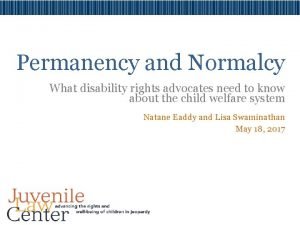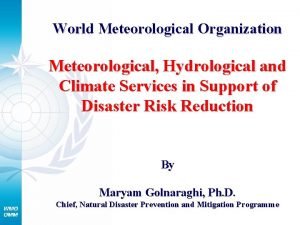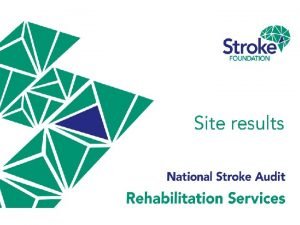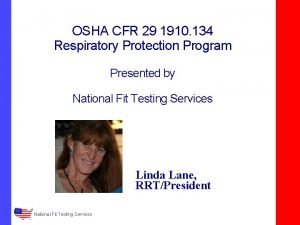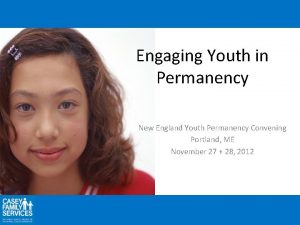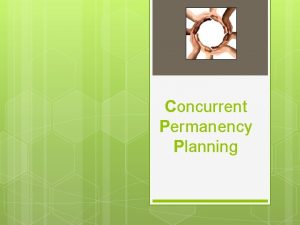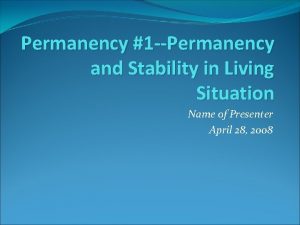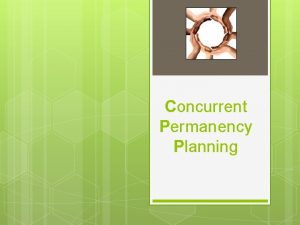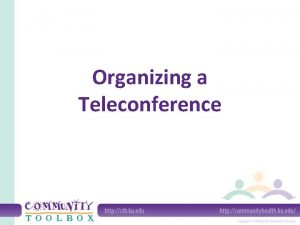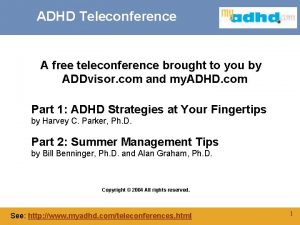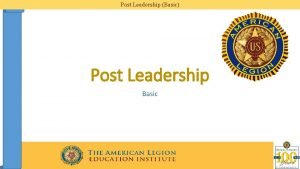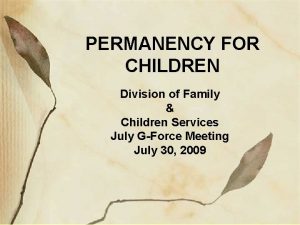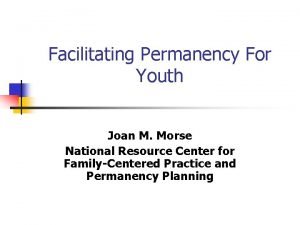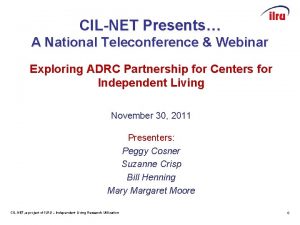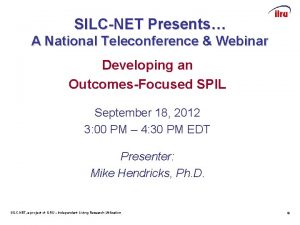A Teleconference on Post Permanency Services The National














































- Slides: 46

A Teleconference on Post Permanency Services The National Resource Center on Foster Care and Permanency Planning The National Resource Center on Special Needs Adoption The National Resource Center for Organizational Improvement June 10, 2004

An Approach to Post Permanency Services A Summary of the Report Strengthening Families and Communities: An Approach to Post-Adoption Services A White Paper October, 2002

Purpose of the Report This report evolved out of a conference convened by Casey Family Services and cosponsored by APHSA, The Center for Family Connections, Boston College Graduate School of Social Work, CWLA, NRCFCPP, NRCSNA, and NACAC in December of 2000. This gathering was convened to highlight the common concerns and issues faced by public and private adoption agencies across the nation with respect to Post -Adoption Services and Supports (PASS).

Trends and Issues in Adoption Since 1997, with the implementation of AFSA, the number of children in foster care whose adoption has been finalized has increased yearly. In FY ’ 02 46, 668 children were adopted across the country. Nationally, 59% of these children are adopted from the public child welfare system were adopted by their current foster parents.

Trends and Issues in Adoption con’t n n n At the same time, the implementation of ASFA has created a large and growing group of children in foster care who are “waiting to be adopted. ” As of March, 2003, there were 116, 653 children and youth with a goal of adoption. In total there were 126, 000 children waiting to be adopted in March, 2003.

Trends and Issues in Adoption con’t n n n Of the 126, 000 children waiting for adoption: 53% were male, 47% were female 34% were white; 45% were African. American; 12% were Latino; 2% were Indian; 4% were of un determined race, 2% were of mixed racial heritage Average of a child waiting to be adopted was just over 8 years Average length of stay in foster care close to 4 years

Trends and Issues in Adoption con’t n n n Most children are in foster care because of abuse or neglect Most have physical health, mental health, and developmental problems resulting from past trauma, drug & alcohol exposure, and multiple separations and losses Most children in foster care have physical, emotional, and behavioral problems that can create significant ongoing challenges for them and their adoptive families – challenges which require services and supports prior to, during, and after their adoption into permanent families.

The Growing Importance of Post. Permanency Service n n n The need for on-going services and supports for adoptive families to ensure that adoptions and permanency is sustained over time. Assurances to families that post-permanency services will be made available to them over time. Full continuum of services including general support, preventive services, crisis intervention and intensive ongoing services to sustain and strengthen permanent families

The Growing Importance of Post. Permanency Service con’t n n n Services for children adopted from foster care, from private agencies and international agencies is essential. Even children adopted as infants, suffer from separation and loss related issues Infants adopted with prenatal exposure to drugs and alcohol may require additional services to assist with the physical, emotional, and developmental repercussions of such exposure.

Principles for Post Permanency Services n n n Availability of services to all families who need them A broad network of permanency-competent, culturally responsive community-based services On-going availability of adoption-competent services as families need them

Commonly Requested Post Permanency Services v v v v v Crisis intervention; Educational support; Summer camp; Respite; Medical services; Supplies & Equipment; Individual therapy; Family therapy; Adoption search v v v v Support groups; Residential treatment; Day treatment; In-home services; Post-finalization case; management; Parent training; Financial assistance; Supplies and equipment

Post-Permanency Program Elements 1. Program designs based on feedback from permanent families. q Using surveys, focus groups, and advisory boards, a number of states, have developed post permanency services based on information obtained directly from resource families to provide guidance on how programs should be developed. A program model in Alabama was developed after a survey was sent to 740 families to determine the most desired services.

Post-Permanency Program Elements 2. Connecting permanent families with information. q Some states have provided ready access to information regarding services and supports including: databases, newsletters on training, books and other shorter publications, translation of materials, and “warm lines. ” Maine has an excellent resource guide in their state to assist families in obtaining necessary services across their state.

Post-Permanency Program Elements 3. Connecting resource families with one another. q Buddy systems, matching experienced and new resource parents, social support groups, and opportunities for parents to connect. Iowa is one state through their Foster and Adoptive Parent Association that has done an excellent job in this area, many other states have similar Associations designed to connect resource families with one another. Mentoring Families have been utilized in Connecticut.

Post-Permanency Program Elements 4. Training for permanency families. q Many states offer educational programs for prospective and experienced resource parents – along with continuing education credits toward a degree – New Hampshire has and excellent training program which models this type of support; nationally NACAC and NFPA holds annual conferences. Arizona also has an extensive training program for families.

Post-Permanency Program Elements 5. Respite services. q Many families create their own informal arrangements for a “timeout, ” but states are increasingly developing more formal opportunities – Louisiana is one state that is working toward developing respite guidelines for post-adoption services. A recent report by CWLA and ARCH and sponsored by Casey Family Programs may be helpful to those exploring respite services.

Post-Permanency Program Elements 6. Local or regional support teams. q Local and regional teams to respond to the needs of families to know services that exists in all communities around the state and to address services gaps – The Rocky Mountain Adoption Exchange and teams in Colorado, New Mexico, South Dakota, and Nevada developed “how to” manuals to assist others in developing team models and improving interdisciplinary collaboration.

Post-Permanency Program Elements 7. Case advocacy. q Many parents need assistance in learning how to advocate on behalf of their children. Some states include case advocacy and systems advocacy as part of their post adoption continuum, especially with respect to advocating for children’s educational needs – Casey Family Services in New England has done an excellent job in this area

Post-Permanency Program Elements 8. A range of treatment options q Many children, because of their traumatic histories of abuse, neglect, and abandonment will need mental health services and families will need help in how to support them. States need access to a full range of community-based, adoption competent, treatment options that include: home based services, outpatient services, day treatment and residential treatment programs as appropriate. Family Resources Centers in Minnesota have been successful as a model.

Systems Related Elements 1. Flexibility in funding to create a network of post-permanency services q States need to use their dollars flexibly to create a network of post-permanency services that include: preventive services, play therapy, crisis intervention, family stabilization, respite care, service coordination, and other services as needed. A key factor here is publicprivate partnerships. Texas is a state that has developed some very innovative practices in this area.

Systems Related Elements 2. Use of existing dollars and creation of new funding streams q States such as Oregon, Illinois, and Virginia, have begun to utilize federal funding through Title IV-E, Part 2 of the Safe and Stable Families Act to provide post-adoption services. Maine uses Medicaid funding, NJ uses a mix of state and federal funding; Massachusetts succeeded in having the state dedicate substantial funding for postadoption services.

Systems Related Elements 3. Financial assistance for adoptive families q Some states developed policies and programs that enhance financial assistance available to adoptive families, offering for example adoption subsidies to all children adopted from foster care, irrespective of Title IV-E eligibility; or offering a “client fund” that allows each adoptive family to request up to $500 each year to pay for a variety of services that they might need (tutoring, respite, co-payments for health care insurance or special camps). Illinois and Ohio are two states that have developed innovative approaches to subsidies and services.

Systems Related Elements 4. Training for professionals who work with resource families q Some states offer training on adoption/foster care related issues for professionals including issues of separation and loss, grief, developmental stages of adoption, importance of the birth family, and cultural competency.

Systems Related Elements 5. Evaluation q Some states include an evaluative component that facilitates program assessment from the perspective of adoptive/foster families – in response to what they have learned, some states have modified their programs. Kentucky, Massachusetts, Illinois, Iowa, and Connecticut are some states that have evaluated their post-permanency services

RECOMMENDATIONS 1. Adoption subsidies should be made based on the special needs of the children, not on the eligibility requirements of their adoptive parents.

RECOMMENDATIONS 2. All states should become party to the Interstate Compact on Adoption Medical Assistance to insure that children receive medical and other services when adopted by families who live in other states or who move across state lines.

RECOMMENDATIONS 3. Flexible federal funds should be available to states to continue a comprehensive array of adoptioncompetent, culturally relevant community-based services and supports to meet the on-going needs of children and their adoptive families

RECOMMENDATIONS 4. An array of federal and state funded adoption-competent comprehensive mental health services that are easily accessible to adoptive families needs to be made available.

RECOMMENDATIONS 5. Policy that ensures adoptive families access to residential treatment services as appropriate without relinquishment of their custody needs to be made available.

RECOMMENDATIONS 6. States should be required or encouraged to track the entry and re-entry to foster care of children adopted through the public child welfare system and by other means.

RECOMMENDATIONS 7. Public and private child welfare agencies should collaborate to engage in a public education initiative to increase the understanding of adoption-related issues and the benefits of postpermanency services

RECOMMENDATIONS 8. States should support training collaborations, multi-disciplinary service practitioners, and professions to strengthen their understanding of adoption and the issues confronting adoptive children and their families, and to enhance their skills to effectively assist them.

RECOMMENDATIONS 9. Public and private child welfare agencies should provide complete and accurate information about adoption subsidies prior to adoption, and a clear process for review and approval of subsidies after adoption finalization

RECOMMENDATIONS 10. Public and private agencies should strengthen their collaboration efforts with adoptive families and other community resources to focus on enhancing post permanency services

RECOMMENDATIONS 11. Public and private child welfare agencies should collaborate with universities and other research organizations to expand the knowledge base about post-permanency services through greater financial and programmatic support for research and other evaluation activities

RECOMMENDATIONS 12. Child welfare agencies should seek feedback from adoptive parents and adoptive youth to strengthen training programs; and engage them in the design and implementation of postpermanency services

RECOMMENDATIONS 13. States should make greater use of technology to create centralized information systems on existing services and supports for adoptive families

Conclusions Post-Permanency Services must be grounded in three key principles: 1. 2. 3. Permanency competent services should be available to all adoptive families who need them, irrespective of their children’s origins; A full array of services should be available in response to the range of the families’ needs; Services should be available over time as permanency related issues arise and impact on children, youth, and families – before, during, and after adoptions occur.

Select Resources/References Casey Family Services. (2002). Strengthening Families and Communities: An Approach to Post Adoption Services – A White paper. Shelton, CT: Casey Family Services. Festinger, T. (2001). After Adoption: A Study of Placement Stability and Parents’ Service Needs. New York: New York Universy study. Howard, J. A. , & Smith, S. L. (1997). Strengthening adoptive families: A synthesis of post-legal adoption opportunities grants. Normal, IL: Illinois State University. Levesque, J. (2001). The Maine Post-Adoption Resource Guide. Augusta, MN: Bureau of Child and Family Services & Child Welfare Training Institute.

Select Resources/References Lenerz, K. (2000). Evaluating post-adoption services: Knowledge from the past, pans for the future. Dialogue, 1(3), 2 -3. Oppenheim, E. , Gruber, S. , & Evans, D. (2000). Report on Post. Adoption Services in the States. Washington, APHSA. Mc. Donald, T. P. , Propp, J. R. , & Murphy, K. C. (2001). The postadoption experience: Child, parent, and family predictors of family adjustment to adoption. Child Welfare, 80(1), 71 -94. Spaulding for Children (2004). Adoption Support and Preservation Services: A Public Interest (2 nd edition). Southfield, MI

Select Resources/References National Foster Parent Association. (2001). NFPA position statement on post permanency services Available online at www. nfpainc. org/issues. html. National Adoption Information Clearinghouse. www. calib. com/naic National Resource Center for Foster Care and Permanency Planning. www. hunter. cuny. edu/socwork/nrcfcpp National Resource Center for Special Needs Adoption. www. nrcadoption. org

Select Resources/References North American Council on Adoptable Children. (2001). State adoption subsidy profiles. Available online at www. nacac. org/subsidy_stateprofiles. html. St. Paul, MN: Author. National Adoption Center (800) TO-ADOPT Assessing the Field of Post-Adoption Services: Family Needs, Program Models, and Evaluation Issues. Aspe. hhs. gov/hsp/postadoption 01/index. htm

The National Resource Centers for Foster Care and Permanency Planning/Special Needs Adoption Can Help Training Every state, territory and tribe is entitled to ten free days of on-site professional training in areas where they have determined need, especially in the area of post permanency services with Regional Office approval. Technical Assistance Every state, territory and tribe is entitled to ten free days of technical assistance in areas where they have determined need, especially in the area of post permanency services with Regional Office approval.

The National Resource Center for Foster Care and Permanency Planning Gerald P. Mallon, DSW Associate Professor and Executive Director National Resource Center for Foster Care and Permanency Planning at the Hunter College School of Social Work A Service of the Children’s Bureau/ACF-DHHS 129 East 79 th Street New York, New York 10021 (212) 452 -7043/direct; (212) 452 -7051/fax mrengmal@aol. com - Email www. hunter. cuny. edusocworknrcfcpp - Website

The National Resource Center for Foster Care and Permanency Planning Natalie Lyons, MSW Director National Resource Center for Special Needs Adoption at Spaulding for Children A Service of the Children’s Bureau/ACF-DHHS 16250 Northland Drive, Suite 120 Southfield, Michigan 48075 Phone: 248 -443 -0306· Fax: 248 -443 -7099 Email: nlyons@nrcadoption. org http: //www. nrcadoption. org/index. htm- Website

The National Resource Center for Foster Care and Permanency Planning Kris Sahonchik, Esq. Director National Resource Center for Organizational Improvement A Service of the Children’s Bureau/ACF-DHHS Institute for Child & Family Policy Muskie School of Public Service University of Southern Maine PO Box 15010, 400 Congress Street Portland, Maine 04112 (207) 780 -5810/phone (207) 780 -5817/fax http: //muskie. usm. maine. edu/helpkids/ - Website
 Permanency plan example
Permanency plan example Hình ảnh bộ gõ cơ thể búng tay
Hình ảnh bộ gõ cơ thể búng tay Ng-html
Ng-html Bổ thể
Bổ thể Tỉ lệ cơ thể trẻ em
Tỉ lệ cơ thể trẻ em Voi kéo gỗ như thế nào
Voi kéo gỗ như thế nào Glasgow thang điểm
Glasgow thang điểm Chúa yêu trần thế alleluia
Chúa yêu trần thế alleluia Môn thể thao bắt đầu bằng chữ f
Môn thể thao bắt đầu bằng chữ f Thế nào là hệ số cao nhất
Thế nào là hệ số cao nhất Các châu lục và đại dương trên thế giới
Các châu lục và đại dương trên thế giới Công thức tính thế năng
Công thức tính thế năng Trời xanh đây là của chúng ta thể thơ
Trời xanh đây là của chúng ta thể thơ Mật thư tọa độ 5x5
Mật thư tọa độ 5x5 Làm thế nào để 102-1=99
Làm thế nào để 102-1=99 độ dài liên kết
độ dài liên kết Các châu lục và đại dương trên thế giới
Các châu lục và đại dương trên thế giới Thơ thất ngôn tứ tuyệt đường luật
Thơ thất ngôn tứ tuyệt đường luật Quá trình desamine hóa có thể tạo ra
Quá trình desamine hóa có thể tạo ra Một số thể thơ truyền thống
Một số thể thơ truyền thống Cái miệng bé xinh thế chỉ nói điều hay thôi
Cái miệng bé xinh thế chỉ nói điều hay thôi Vẽ hình chiếu vuông góc của vật thể sau
Vẽ hình chiếu vuông góc của vật thể sau Nguyên nhân của sự mỏi cơ sinh 8
Nguyên nhân của sự mỏi cơ sinh 8 đặc điểm cơ thể của người tối cổ
đặc điểm cơ thể của người tối cổ V cc cc
V cc cc Vẽ hình chiếu đứng bằng cạnh của vật thể
Vẽ hình chiếu đứng bằng cạnh của vật thể Vẽ hình chiếu vuông góc của vật thể sau
Vẽ hình chiếu vuông góc của vật thể sau Thẻ vin
Thẻ vin đại từ thay thế
đại từ thay thế điện thế nghỉ
điện thế nghỉ Tư thế ngồi viết
Tư thế ngồi viết Diễn thế sinh thái là
Diễn thế sinh thái là Dot
Dot Các số nguyên tố
Các số nguyên tố Tư thế ngồi viết
Tư thế ngồi viết Lời thề hippocrates
Lời thề hippocrates Thiếu nhi thế giới liên hoan
Thiếu nhi thế giới liên hoan ưu thế lai là gì
ưu thế lai là gì Khi nào hổ con có thể sống độc lập
Khi nào hổ con có thể sống độc lập Khi nào hổ con có thể sống độc lập
Khi nào hổ con có thể sống độc lập Sơ đồ cơ thể người
Sơ đồ cơ thể người Từ ngữ thể hiện lòng nhân hậu
Từ ngữ thể hiện lòng nhân hậu Thế nào là mạng điện lắp đặt kiểu nổi
Thế nào là mạng điện lắp đặt kiểu nổi National unification and the national state
National unification and the national state National meteorological and hydrological services
National meteorological and hydrological services National stroke audit rehabilitation services
National stroke audit rehabilitation services 1910 134
1910 134
